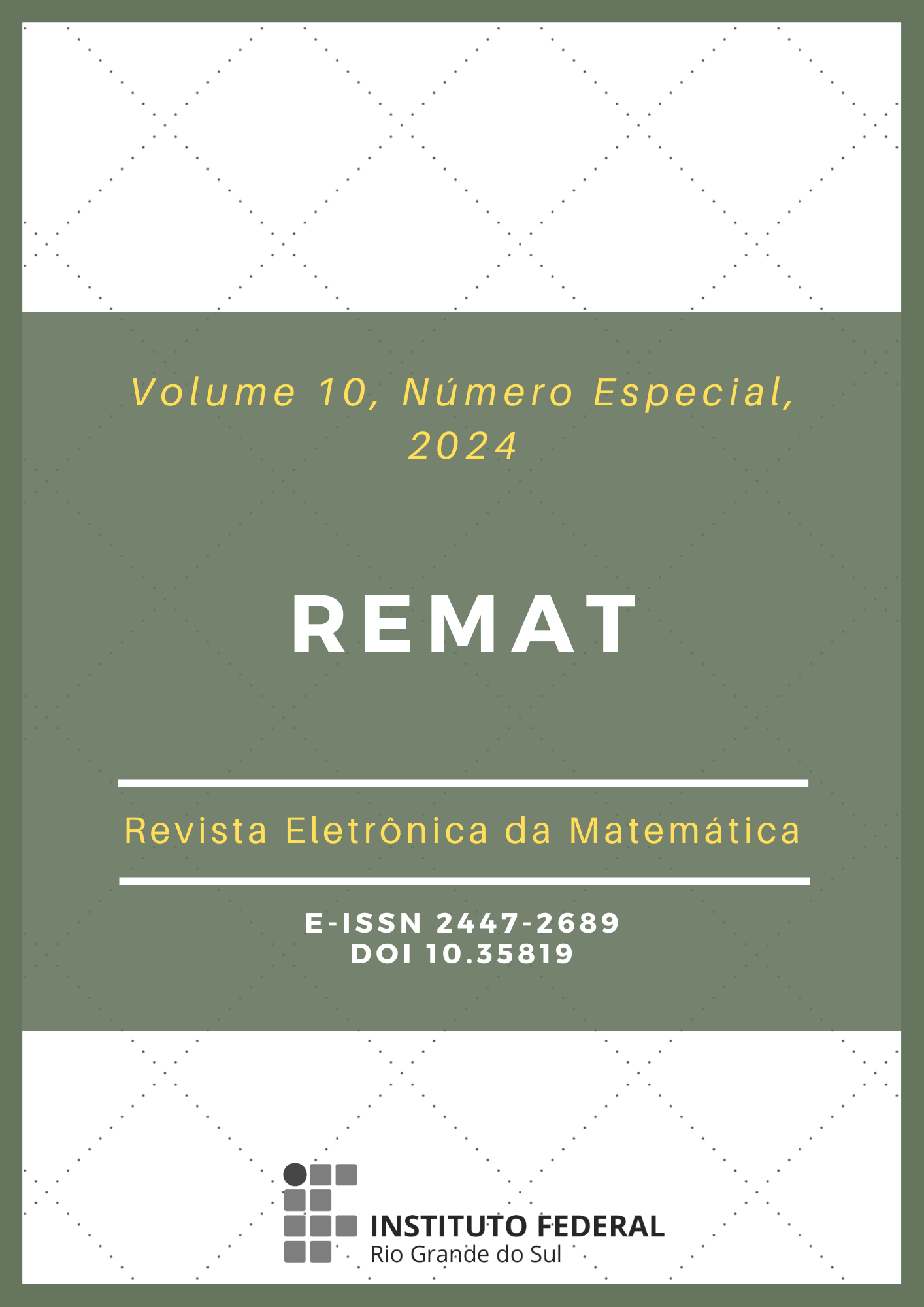A framework for solving the inverse scattering problem based on the Ultra Weak Variational Formulation
DOI:
https://doi.org/10.35819/remat2024v10iespecialid7053Keywords:
inverse problems, mild-slope equation, ultra weak variational formulationAbstract
This study focuses on two-dimensional inverse scattering problems, where information about an inaccessible region is inferred from measurements taken in accessible areas. The main focus is on the iterative resolution of the refraction-diffraction coefficient in the Helmholtz equation, using a regularized minimum square problem to cope with the ill-posed nature of the problem. To solve the corresponding direct problem, the Ultra Weak Variational Formulation (UWVF) method was applied, a method known for its computational efficiency, requiring fewer resources and allowing for analytical calculations. The methodology developed here was successfully applied to determine the bathymetry in coastal regions from the knowledge of waves in deep waters and along the coastline, yielding reliable and precise results.
Downloads
References
ALVAREZ, A. C.; GARCÍA, G. C.; SARKIS, M. The ultra weak variational formulation for the modified mild-slope equation. Applied Mathematical Modelling. v. 52, p. 28-41, 2017. DOI: https://doi.org/10.1016/j.apm.2017.07.018.
BAO, G.; LI, P. Shape reconstruction of inverse medium scattering for the Helmholtz equation. In: WANG, Y.; YAGOLA, A.; YANG C. (ed.). Computational Methods for Applied Inverse Problems. Berlin, Boston: De Gruyter, 2012. cap. 12. DOI: https://doi.org/10.1515/9783110259056.283.
BERKHOFF, J. C. W. Computation of combined refraction - diffraction. Coastal Engineering Proceedings. v. 1, n. 13, p. 23, Jan. 1972. DOI: https://doi.org/10.9753/ICCE.V13.23.
BORGES, C.; GILLMAN, A.; GREENGARD, L. High resolution inverse scattering in two dimensions using recursive linearization. SIAM Journal on Imaging Sciences. v. 10, n. 2, p. 641-664, 2017. DOI: https://doi.org/10.1137/16M1093562.
CESSENAT, O.; DESPRÉS, B. Application of an ultra weak variational formulation of elliptic pdes to the two-dimensional helmholtz problem. SIAM Journal on Numerical Analysis. v. 35, n. 1, p. 255-299, 1998. DOI: https://doi.org/10.1137/S0036142995285873.
CESSENAT, O.; DESPRÉS, B. Using plane waves as base functions for solving time harmonic equations with the ultra weak variational formulation. Journal of Computational Acoustics. v. 11, n. 2, p. 227-238, 2003. DOI: https://doi.org/10.1142/S0218396X03001912.
CHAMBERLAIN, P.; PORTER, D. The modified mild-slope equation. Journal of Fluid Mechanics. v. 291, p. 393-407, 1995. DOI: https://doi.org/10.1017/S0022112095002758.
CHEN, H. S.; HOUSTON, J. R. Calculation of Water Oscillation in Coastal Harbors. HARBS and HARBD User's Manual. Vicksburg, Mississippi: U. S. Army Engineer Research and Development Center (ERDC) (Instruction Report, CERC-87-2), 1987. Disponível em: https://hdl.handle.net/20.500.11970/111457. Acesso em: 25 jun. 2024.
COLLINS, R. Nondestructive testing of materials. Amsterdam: IOS Press, 1995. v. 8.
FASSIEH, K. M. A numerical technique to estimate water depths from remotely sensed water wave characteristics. ISRN Oceanography. v. 2013, 2013.
GILBERT, R. P.; XU, Y. An inverse problem for harmonic acoustics in stratified oceans. Journal of Mathematical Analysis and Applications, v. 176, n. 1, p. 121-137, 1993. DOI: https://doi.org/10.1006/jmaa.1993.1203.
GYLYS-COLWELL, F. An inverse problem for the Helmholtz equation. Inverse Problems. v. 12, n. 2, p. 139-156, 1996. DOI: https://doi.org/10.1088/0266-5611/12/2/003.
HUTTUNEN T.; MONK, P.; KAIPIO, J. p. Computational aspects of the ultra-weak variational formulation. Journal of Computational Physics. v. 182, n. 1, p. 27-46, 2002. DOI: https://doi.org/10.1006/jcph.2002.7148.
LE ROUX, J. P. An extension of the airy theory for linear waves into shallow water. Coastal Engineering. v. 55, n. 4, p. 295-301, 2008. DOI: https://doi.org/10.1016/j.coastaleng.2007.11.003.
PASTORINO, M. Medical and industrial applications of inverse scattering based microwave imaging techniques. 2008 IEEE International Workshop on Imaging Systems and Techniques. Chania, Greece: IEEE, 2008. p. 34-38. DOI: https://doi.org/10.1109/IST.2008.4659936.
RADDER, A. C. On the parabolic equation method for water wave transformation. Journal of Fluid Mechanics. v. 95, n. 1, p. 159-176, 1979. DOI: https://doi.org/10.1017/S0022112079001397.
TARANTOLA, A. Inverse problem theory and methods for model parameter estimation. USA: SIAM, 2005.
TIKHONOV, A. N.; ARSENIN, V. Y. Solutions of ill-posed problems. Washington: V. H. Winston & Sons, 1977.
TSAY, T.-K.; LIU, P. L.-F. A finite element model for wave refraction and diffraction. Applied Ocean Research. v. 5, n. 1, p. 30-37, 1983. DOI: https://doi.org/10.1016/0141-1187(83)90055-X.
VASAN, V.; DECONINCK, B. The inverse water wave problem of bathymetry detection. Journal of Fluid Mechanics. v. 714, p. 562-590, 2013. DOI: https://doi.org/10.1017/jfm.2012.497.
WANG, Y. Regularization for inverse models in remote sensing. Progress in Physical Geography: Earth and Environment. v. 36, n. 1, p. 38-59, 2012. DOI: https://doi.org/10.1177/0309133311420320.
Downloads
Published
Issue
Section
License
Copyright (c) 2024 REMAT: Revista Eletrônica da Matemática

This work is licensed under a Creative Commons Attribution 4.0 International License.
REMAT retains the copyright of published articles, having the right to first publication of the work, mention of first publication in the journal in other published media and distribution of parts or of the work as a whole in order to promote the magazine.
This is an open access journal, which means that all content is available free of charge, at no cost to the user or his institution. Users are permitted to read, download, copy, distribute, print, search or link the full texts of the articles, or use them for any other legal purpose, without requesting prior permission from the magazine or the author. This statement is in accordance with the BOAI definition of open access.













 https://orcid.org/0000-0002-0893-7426
https://orcid.org/0000-0002-0893-7426


















